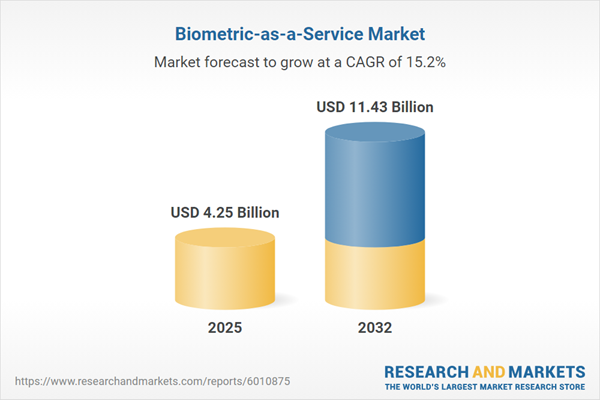Speak directly to the analyst to clarify any post sales queries you may have.
The Biometric-as-a-Service market is rapidly advancing as organizations worldwide look to strengthen security and streamline identity verification across expanding digital platforms. This evolution is framing new industry standards and unlocking competitive advantages for enterprises seeking resilient, scalable solutions.
Market Snapshot: Biometric-as-a-Service Market Growth Overview
The Biometric-as-a-Service Market is experiencing robust momentum, expanding from USD 3.68 billion in 2024 to USD 4.25 billion in 2025, and is projected to register a compound annual growth rate (CAGR) of 15.19%, ultimately reaching USD 11.43 billion by 2032. Market growth is fueled by escalating digitalization, evolving security mandates, and persistent demands for seamless yet secure authentication across diverse sectors.
Scope & Segmentation
- End User: BFSI, government, healthcare, IT & telecommunications, retail
- Biometric Modality: Face, fingerprint, iris, voice
- Deployment Mode: Cloud, hybrid, on-premises
- Service Type: Managed services (pay per use, subscription), support and maintenance (breakfix, upgrade)
- Enterprise Size: Large enterprises, small and medium enterprises
- Authentication Mode: Continuous authentication, single factor, multi-factor (three factor, two factor)
- Regional Coverage: Americas (North America, Latin America), EMEA (Europe, Middle East, Africa), Asia-Pacific (including China, India, Japan, Australia, South Korea, and Southeast Asia markets)
- Leading Vendors: Thales S.A., NEC Corporation, IDEMIA, Amazon Web Services, Inc., Microsoft Corporation, Daon, Inc., Aware, Inc., Bio-key International, Inc., Suprema Inc., BioCatch Ltd.
Key Takeaways: Strategic Insights Driving Biometric-as-a-Service Adoption
- Adoption by highly regulated industries, such as financial services and government, is accelerating due to advanced compliance requirements and the rise in digital threats.
- Advancements in machine learning and neural networks are significantly raising biometric recognition accuracy, improving both user experience and security posture.
- The expansion of edge computing supports local processing, optimizing latency and enhancing privacy for data-sensitive operations.
- New service models, including on-demand and subscription options, enable organizations of various sizes to adopt solutions flexibly and manage costs more effectively.
- Integration with emerging technologies, such as blockchain-based identity wallets, supports universal, user-centric approaches in identity management.
- Increasing standardization and regulatory alignment at both global and regional levels are building market confidence, especially in privacy-sensitive sectors.
Tariff Impact: Responding to Cost Structure and Supply Chain Shifts
Recent United States tariffs on imported hardware and software components have prompted vendors to restructure procurement strategies and prioritize domestic supplier relationships. This has driven investments in local R&D and onshore manufacturing, resulting in more adaptable supply chains and reduced reliance on imports. Meanwhile, service providers are offering revised subscription and pay-per-use models to help enterprise clients manage price volatility without sacrificing robust security coverage. These industry adjustments underscore both short-term challenges and long-term resilience, spurring innovation in product development and regional sourcing.
Methodology & Data Sources
This report employs a multi-stage methodology, including secondary research and triangulation of industry data, combined with qualitative interviews of executives, architects, and domain experts. Primary insights are validated through stakeholder workshops and peer review by technical specialists. This ensures that market intelligence is credible, timely, and aligned with practical realities.
Why This Report Matters
- Helps decision-makers benchmark technology adoption, service models, and vendor dynamics across global and regional markets.
- Equips organizations with actionable strategies to address regulatory changes, supply chain disruptions, and the fast pace of technological evolution.
Conclusion
Organizations seeking a future-ready approach to security and identity management can leverage this research to navigate complexity, foster compliance, and maximize operational agility in the evolving Biometric-as-a-Service landscape.
Additional Product Information:
- Purchase of this report includes 1 year online access with quarterly updates.
- This report can be updated on request. Please contact our Customer Experience team using the Ask a Question widget on our website.
Table of Contents
3. Executive Summary
4. Market Overview
7. Cumulative Impact of Artificial Intelligence 2025
Companies Mentioned
The companies profiled in this Biometric-as-a-Service market report include:- Thales S.A.
- NEC Corporation
- IDEMIA
- Amazon Web Services, Inc.
- Microsoft Corporation
- Daon, Inc.
- Aware, Inc.
- Bio-key International, Inc.
- Suprema Inc.
- BioCatch Ltd.
Table Information
| Report Attribute | Details |
|---|---|
| No. of Pages | 189 |
| Published | October 2025 |
| Forecast Period | 2025 - 2032 |
| Estimated Market Value ( USD | $ 4.25 Billion |
| Forecasted Market Value ( USD | $ 11.43 Billion |
| Compound Annual Growth Rate | 15.1% |
| Regions Covered | Global |
| No. of Companies Mentioned | 11 |









